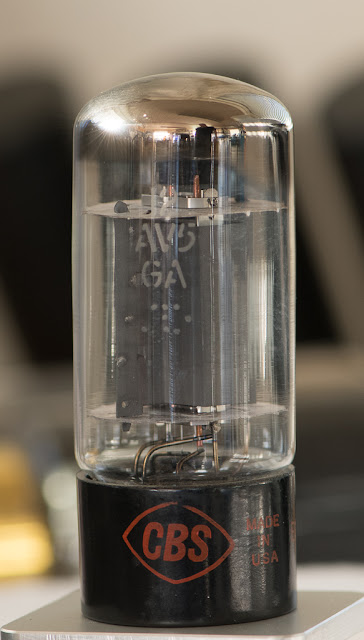Last year the December tube was a beam pentode designed for horizontal deflection service in TVs. So let's have a look at a similar one this year: The 12AV5.
Like the 6FW5 shown last year, the 12AV5 makes a nice pseudo triode when the screen grid is connected to the plate.
 It is also available as a 6.3V heater variant (6AV5) but I only have 12,6V versions. The 12AV5 has an Octal base and no top cap. The pinout is shown on the left. It has a rather low maximum plate dissipation of 11W. So the maximum power which can be extracted from it in single ended triode service is 2-3W. These TV tubes can take some abuse and I would not be scared to run it right at the allowed limit. It would probably make a nice low cost alternative to the 45. For the complete technical specs, see the General Electric data sheet. Especially the 12,6V variant can be easily found for cheap. So no need to complain about the rising prices of NOS tubes. If you are on a budget, take a side step off the main stream. As aways let's have a look at the triode connected plate curves:
It is also available as a 6.3V heater variant (6AV5) but I only have 12,6V versions. The 12AV5 has an Octal base and no top cap. The pinout is shown on the left. It has a rather low maximum plate dissipation of 11W. So the maximum power which can be extracted from it in single ended triode service is 2-3W. These TV tubes can take some abuse and I would not be scared to run it right at the allowed limit. It would probably make a nice low cost alternative to the 45. For the complete technical specs, see the General Electric data sheet. Especially the 12,6V variant can be easily found for cheap. So no need to complain about the rising prices of NOS tubes. If you are on a budget, take a side step off the main stream. As aways let's have a look at the triode connected plate curves:Here some 12AV5 made by Raytheon:
A nice chubby little tube.
For just 11W dissipation the plate looks massive.
Some close ups:
CBS 12A5GA:
General Electric:
For examining the internal construction, this one has to die:
Removing the glass:
Clipping off the base:
Heater wire partially pulled out of the cathode sleeve:
The heater:
The plate:
Cathode, grids and beam forming plate:
Removing the beam plate:
Separating cathode and grids:
The cathode:
Screen grid, graphite coated to increase heat dissipation:
Control grid, gold plated to decrease secondary emission:
Those TV tubes were well made and produced at a time when tube manufacturing technology was very mature.
And lastly some photos of the tube in operation.
Best regards
Thomas
















































Hi Thomas,
ReplyDeleteHow does it compare to the “large triode” section of the 6EM7? Will it make a good SE driver for IT coupling/splitting to dht’s like the 300B for PP? Similar plate resistance when triode strapped? Thanks! Merry Christmas....
Hi! I didn't characterise all parameters in triode mode. The tubes are easy and cheap to find. Just buy some and test if they fulfil your requirements
DeleteThomas
Hello.
ReplyDeleteI am sorry for asking so many questions about your tube characteristics but I am making LTSpice models from real charts because what is on the network has a lot of errors. Therefore, once again I am asking for X =? V / step Y =? MA / step grid step =? V
In exchange for help, I can send the models I made.
Greetings
I don't think making a spice model from a set of curves of a single tube makes a lot of sense. have you compared plate curves between different tube samples? They can be very different, especially for pentodes in triode connection. Sorry I did not note the settings as those curves only serve an illustrative purpose and not an exact measurement
Delete"It has a rather low maximum plate dissipation of 11W. So the maximum power which can be extracted from it in single ended triode service is 2-3W. These TV tubes can take some abuse and I would not be scared to run it right at the allowed limit".
DeleteThe 12AV5 is nearly identical with the 6BQ6GA, and I've run 6BQ6s at Pd= 17.5W with no problems. Audio isn't the brick on the key mode that HD duty is, so the ratings are *very* conservative. The RCA gray plate 'BQ6s can pull up to 70mA before showing colour. The Sylvania black plate 'BQ6s don't show any colour even in the dark at 70mA. 350Vdc in both cases. Therefore, I settled on a bias current of 50mA that definitely improved the sonic performance over 25mA that kept Pd in spec.